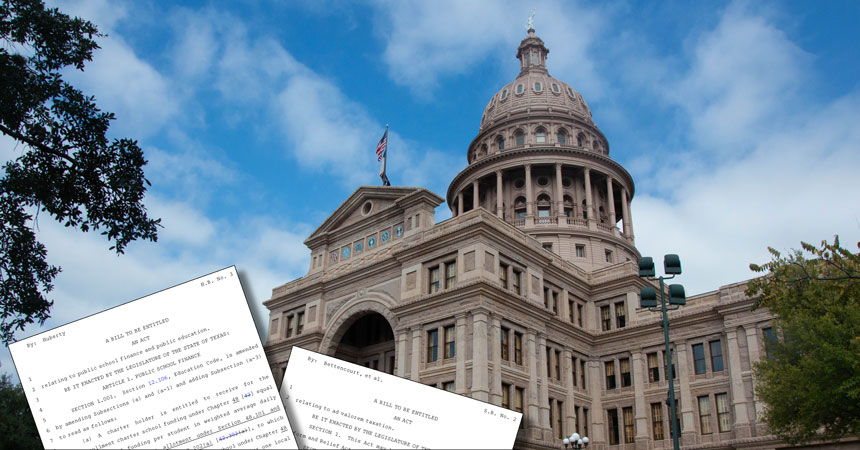Fiscal Highlights from the 86th Legislature Legislative Session Tackled Public Education, Property Taxes

The 86th Texas Legislature met in 2019 to write the state’s next budget and tackle a perennial challenge for Texas lawmakers — meaningful reforms to public education and the state’s local property tax system.
In January, Comptroller Glenn Hegar provided a robust biennial revenue estimate (BRE) for the state, reporting that Texas’ revenues would support $119 billion in general-purpose spending for the 2020-21 biennium, 8.1 percent more than in 2018-19. All revenue sources, including federal aid and dedicated funds, brought the total amount to $266 billion available for the budget. The reasonably good fiscal news helped set an amicable tone for the session. And near the end, with time for budget negotiations shrinking to days, Hegar delivered more good news to lawmakers: an increase in the BRE of $518 million.
A $251 Billion Budget
Of 7,324 House and Senate bills filed before and during session, 1,373 became law (Exhibit 1), including and most importantly House Bill (HB) 1, the General Appropriations Act that funds the state’s budget. Under HB 1, the Legislature appropriated nearly $252 billion in all funds for the 2020-21 budget, a 4.9 percent increase from the last biennium.
Exhibit 1
| House and Senate bills filed | 7,324 |
|---|---|
| Passed | 1,429 |
| Vetoed by the Governor | 56 |
Note: Does not include resolutions, memorial motions, etc.
Source: Legislative Reference Library of Texas
Public schools, colleges and universities account for $95.7 billion of the budget; their share rose by 16 percent from last session. About $84 billion is headed to health and human services programs, 1 percent more than in the last biennium but offset to 0.4 percent by a $900 million cut in the state’s Medicaid budget.
As has been the case for many years, the bulk of the 2020-21 biennial budget is devoted to education and health and human services (Exhibit 2).
Exhibit 2
| All Functions | Expended/Budgeted 2018-19 | Appropriated 2020-21 | Biennial Change | Percentage Change |
|---|---|---|---|---|
| Article I – General Government | $7,781.1 | $7,440.2 | -$341.0 | -4.4% |
| Article II – Health and Human Services | 84,036.3 | 84,368.7 | 332.4 | 0.4 |
| Article III – Agencies of Education | 82,214.8 | 95,685.9 | 13,471.0 | 16.4 |
| Public Education | 61,315.5 | 73,833.1 | 12,517.6 | 20.4 |
| Higher Education | 20,899.4 | 21,852.8 | 953.4 | 4.6 |
| Article IV – The Judiciary | 857.1 | 892.3 | 35.3 | 4.1 |
| Article V – Public Safety and Criminal Justice | 18,857.9 | 16,040.3 | -2,817.6 | -14.9 |
| Article VI – Natural Resources | 8,428.0 | 9,013.0 | 585.0 | 6.9 |
| Article VII – Business and Economic Development | 36,721.5 | 37,062.4 | 340.9 | 0.9 |
| Article VIII – Regulatory | 677.8 | 647.4 | -30.4 | -4.5 |
| Article IX – General Provisions | 0.0 | 285.3 | 285.3 | N/A |
| Article X – The Legislature | 392.8 | 392.1 | -0.8 | -0.2 |
| TOTAL, ALL FUNCTIONS | $239,967.3 | $251,827.6 | $11,860.3 | 4.9% |
Notes: Totals include the net effect of House Bill 1 (General Appropriations Act), Senate Bill 500 (supplemental appropriations) and House Bill 4071 (miscellaneous claims). These amounts have been adjusted to include supplemental spending in fiscal 2019. These estimates are preliminary and subject to change based on the future actions of the 86th Legislature and final reconciliations by the staff of the Legislative Budget Board.
Article IX provides job titles, salary schedules and other provisions related to appropriation authority.
Totals may not add due to rounding.
Source: Texas Comptroller of Public Accounts
Under Senate Bill (SB) 500, lawmakers also allocated $9.9 billion in supplemental funding for fiscal 2019 and the 2020-21 biennium, in part to pay for certain needs including foster care, Medicaid expenses and Hurricane Harvey-related items. To shore up this supplemental budget, legislators dipped into the state’s Economic Stabilization Fund (ESF), the “Rainy Day Fund,” for $6.2 billion — the largest such draw in the fund’s history.
Reforming School Finance

The major public school finance bill, HB 3, consumed much of the 140-day session. Sticking points included increases to teachers’ pay and the reduction of school district property taxes. The Senate and House both proposed pay raises, lower school district tax rates and higher state spending on school districts, all measures involving sizeable expenditures.
Lawmakers finally agreed to use state funds to “buy down” $5 billion in school district property taxes. In general, HB 3 seeks to push the maintenance and operations (M&O) tax rate for school districts down by an average of 8 cents per $100 of property valuation in 2020 and 13 cents in 2021. And, beginning in 2021, school districts that see growth in their property values above the statewide average will be required to use revenue derived from any growth above 2.5 percent to further reduce their tax rates. (Thus, actual tax rate reductions from this requirement will depend heavily on rising local property values.)
Two Kinds of Property Taxes
In Texas, local property tax rates consist of two parts: the maintenance and operations (M&O) rate, intended to support operating expenditures such as employee salaries, and the interest and sinking (I&S) rate, which generally supports bond debt incurred for facility construction.
In all, HB 3 increased biennial funding by $11.6 billion over the amount that would have been provided under previous law, including $6.5 billion in new funding for schools as well as $5 billion for property tax relief (the “buy-down”). Salary increases for teachers and other staff will vary based on a new statewide formula, years of teaching experience and the extra local money available in each district.
In addition, school districts now are required to devote 30 percent of any gains in their basic allotment of state funds per student to compensation for teachers, counselors, librarians and nurses. This compensation can include benefits such as insurance premiums. These changes took effect at the start of the 2019-20 school year.
HB 3 also increased the basic allotment from $5,140 to $6,160, and increased weights for funding that consider specific student characteristics such as economic disadvantage and the need for special education.
HB 3 also includes funding for full-day pre-kindergarten for eligible children; new incentives for college, career and military readiness; more financial support for special education; financial incentives of $3,000 to $32,000 annually for high-performing teachers who teach in rural and/or low-income districts; and a reduction in “recapture” funds by $3.5 billion compared to the previous biennium. (State law “recaptures” some property tax revenues from property-wealthy districts to supplement poorer districts’ funding.)
More Voter Approval for Local Property Taxes
Many other local government entities besides school districts levy property taxes, including municipalities, counties and special-purpose districts that provide a wide variety of public services. SB 2, the most significant property tax bill, addressed taxes levied by these entities.
Since the 1980s, these taxing authorities have been able to increase their M&O taxes up to 8 percent annually without triggering a provision allowing voters to petition for an election. After SB 2’s passage, beginning in 2020 many of them can’t increase their M&O revenue by more than 3.5 percent in a single year without triggering an automatic election.
The new legislation includes some exceptions, however. Most taxing units subject to the 3.5 percent voter-approval tax rate, as well as municipalities with fewer than 30,000 people, can raise an additional $500,000 annually in M&O revenue without triggering an election, despite the threshold. In addition, junior college districts, hospital districts, certain water districts and taxing units with low proposed M&O tax rates (2.5 cents or less per $100) aren’t subject to the 3.5 percent voter-approval rate and can continue increasing their M&O revenue by up to 8 percent annually. (Again, SB 2’s provisions do not apply to school districts.)
Furthermore, the new legislation allows taxing units to “bank” unused annual tax increases for the three previous years.
Limiting many jurisdictions’ ability to raise M&O revenue without voter approval won’t lower current property tax bills, but may reduce future increases.
Supporting Teachers
While increasing funding for public schools, lawmakers also took steps in the supplemental budget (SB 500) to shore up the Teacher Retirement System (TRS) pension fund.
As reported in the February 2019 Fiscal Notes, the state’s Pension Review Board considers a pension actuarially sound if it can eliminate its unfunded liability in 30 years or less with current contribution rates. The time needed to do so is called the amortization period; at the beginning of the 2019 session, TRS’ was at 32.2 years. To reduce the amortization period, legislators tapped $524 million from the ESF.
With the passage of SB 12, the TRS pension reform bill, the state’s contribution to TRS will rise from a rate of 6.8 percent of payroll to 8.25 percent annually from 2019 to 2024. In the same period, active employees’ shares will increase from 7.7 percent of salary to 8.25 percent and district contributions will grow from 1.5 to 2 percent. Current TRS retirees also will receive a one-time extra annuity check, or “13th check,” also funded from the ESF. This will be either for the amount of their monthly annuity payment or $2,000, whichever is less, at a cost to the state of $589 million.
These moves open the door for a cost-of-living increase for retired teachers in the next legislative session. By law, such increases can’t occur unless the pension is actuarially sound.
The Legislature also made appropriations to TRS-Care, the retiree health care plan. That will stave off a premium increase for plan members in 2020.
Making Way for Wayfair
Last year’s decision by the U.S. Supreme Court in South Dakota v. Wayfair overruled prior decisions that a state could impose sales and use tax collection responsibilities only on sellers with a physical presence in that state. (Wayfair is discussed elsewhere in this issue.)
While Texas has a single state sales tax rate, local sales tax rates vary from zero to 2 percent, which could complicate tax remittance and collection responsibilities for out-of-state sellers. With the passage of HB 2153, the Comptroller’s office can set a uniform sales and use tax rate to be collected by remote sellers.
Another new law, HB 1525, requires online “marketplaces” such as Etsy, Amazon and eBay to collect sales and use taxes on sales made by all third-party sellers who sell to Texans through their sites.
Our agency estimates the new laws and rules adopted to implement Wayfair will add $500 million to state coffers annually.
Earning More with the Rainy Day Fund
For several years now, the Comptroller’s office has recommended investing the ESF in assets producing better returns for the state, through an initiative called the Legacy Fund. While lawmakers didn’t create the fund, SB 69 will allow the agency to move up to 75 percent of the Rainy Day Fund into prudent but higher-yield investments that would maintain the state’s purchasing power.
“We’re moving in the right direction,” Hegar said, “and at the very least won’t be treating our savings account like cash buried on the Capitol lawn.” FN
The January 2019 issue of Fiscal Notes provides an in-depth overview of the history of school finance in Texas. More about the health of the state’s pension funds can be found in the February issue at FiscalNotes.com.

